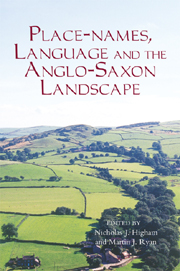Book contents
- Frontmatter
- Contents
- List of Illustrations
- Acknowledgements
- List of Contributors
- Abbreviations
- 1 Place-Names, Language and the Anglo-Saxon Landscape: An Introduction
- 2 The Landscape of Place-Name Studies
- 3 Place-Names as Travellers' Landmarks
- 4 Light thrown by Scandinavian Place-Names on the Anglo-Saxon Landscape
- 5 Language and the Anglo-Saxon Landscape: Towards an Archaeological Interpretation of Place-Names in Wiltshire
- 6 Hunting the Vikings in South Cumbria from Ambleside to Haverbrack
- 7 Viking-Age Amounderness: A Reconsideration
- 8 The Woodland Landscape of Early Medieval England
- 9 The Pre-Conquest Lands and Parish of Crediton Minster, Devon
- 10 Rewriting the Bounds: Pershore's Powick and Leigh
- 11 That ‘Dreary Old Question’: The Hide in Early Anglo-Saxon England
- 12 Boroughs and Socio-Political Reconstruction in Late Anglo-Saxon England
- Index
9 - The Pre-Conquest Lands and Parish of Crediton Minster, Devon
Published online by Cambridge University Press: 05 February 2013
- Frontmatter
- Contents
- List of Illustrations
- Acknowledgements
- List of Contributors
- Abbreviations
- 1 Place-Names, Language and the Anglo-Saxon Landscape: An Introduction
- 2 The Landscape of Place-Name Studies
- 3 Place-Names as Travellers' Landmarks
- 4 Light thrown by Scandinavian Place-Names on the Anglo-Saxon Landscape
- 5 Language and the Anglo-Saxon Landscape: Towards an Archaeological Interpretation of Place-Names in Wiltshire
- 6 Hunting the Vikings in South Cumbria from Ambleside to Haverbrack
- 7 Viking-Age Amounderness: A Reconsideration
- 8 The Woodland Landscape of Early Medieval England
- 9 The Pre-Conquest Lands and Parish of Crediton Minster, Devon
- 10 Rewriting the Bounds: Pershore's Powick and Leigh
- 11 That ‘Dreary Old Question’: The Hide in Early Anglo-Saxon England
- 12 Boroughs and Socio-Political Reconstruction in Late Anglo-Saxon England
- Index
Summary
Introduction
The collegiate church of the Holy Cross and Mary at Crediton, Devon, had probably been in existence for about 800 years by the time that the Reformation deprived it of both its college and its lands. The earliest reference to a church at Crediton is in its putative foundation charter (S 255), which is dated 10 April 739. In its surviving form S 255 is a composite text written shortly after the Norman Conquest and includes interpolated material and an anachronistic boundary clause, yet it is clear that underlying the text is an authentic charter of Æthelheard, king of the West Saxons (726–c. 740). The current consensus is that there seems little reason to suspect its primary content and purpose, namely a grant by the king to Forthhere, bishop of Sherborne, of land ‘to build a minster in the place where it is called Cridie’. There is no further mention of this minster until the early tenth century, nor has any early fabric survived. It is therefore primarily an assumption – albeit a reasonable and not entirely unsupported one – that the minster was built as intended, soon after 739, and that there was institutional continuity thereafter.
The relationships between the original grant, the extant charter and the boundary clause have not fully been resolved, and further ambiguities arise from Crediton's location in what had once been part of the British kingdom of Dumnonia.
- Type
- Chapter
- Information
- Place-names, Language and the Anglo-Saxon Landscape , pp. 175 - 194Publisher: Boydell & BrewerPrint publication year: 2011



